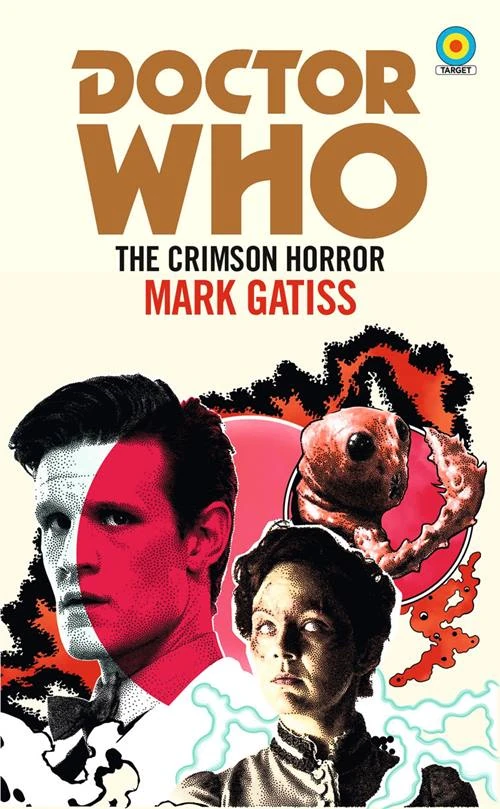The Crimson Horror
Doctor Who - The Crimson Horror

|
The Crimson Horror |
Target novelisation Doctor Who - The Crimson Horror |

|
| Author | Mark Gatiss |  |
| Published | 2021 | |
| ISBN | 978 1 785 94504 5 | |
| First Edition Cover | Anthony Dry |
| Back cover blurb: 'We must get to the bottom of this dark and queer business, no matter what the cost!' Something ghastly is afoot in Victorian Yorkshire. Something that kills. Bodies are washing up in the canal, their skin a waxy, glowing red... But just what is this crimson horror? Madam Vastra, Jenny and Strax are despatched to investigate the mystery. Strangely reluctant to assist their enquiries is Mrs Winifred Gillyflower, matriarch of 'Sweetville', a seemingly utopian workers' community. Why do all roads lead to the team's old friends Clara and the Doctor? Who is Mrs Gillyflower's mysterious silent partner Mr Sweet? And will the motley gang be in time to defeat the mysterious power that threatens all the world with its poison? |
A Study in Crimson by Matthew Kresal 2/7/23
Back in the 1970s and into the 1980s, the only way fans of Doctor Who often could encounter an older story was by reading it. The Target novelizations were slim books, frequently running little more than 150 pages. Yet they became the cornerstone of the show's merchandise. These days, of course, that isn't the case, with options including DVDs and streaming platforms. That hasn't stopped such demand for new Target-style novelizations of twenty-first-century episodes, which BBC Books began obliging with in 2019, with a new batch released in spring 2021. Among the latest entries was The Crimson Horror, the 2013 Eleventh Doctor episode that focused on the Paternoster Gang, adapted by its original writer, Mark Gatiss.
When the original Target books were in their heyday, they generally came in two types. The first, and by far the most common, were straightforward adaptations of the episodes that (at worst) felt like a copy-and-paste of the script with a few lines of description and "said" added. On the other hand, you would also get books that expanded upon the televised stories with more detail and backstories or, in some cases, reinstating material cut for time. The Crimson Horror falls very much in the latter category, helping the 45-minute episode become a 200-page novel (or four-and-a-half-hour audiobook).
Gatiss accomplishes that in no small part by adding what is, in effect, a prologue to the TV episode. One set a few years before with the Eleventh Doctor involved in an adventure with Madame Vastra and Jenny Flint before Strax becomes a part of the gang. This new prologue from Gatiss, set around a theatre holding something akin to a talent competition TV show a century ahead of time, is a fun little piece of work in its own right. Indeed, it would have been a neat separate short story elsewhere. As a prologue to The Crimson Horror, it's still neat but doesn't connect to the events of the episode quite as much as Gatiss (through the character of Jenny Flint, whose memoir makes up much of the narrative both here and throughout the novelization) lets on. Even so, for fans of this Doctor and the Paternoster Gang, it's something that makes the novelization a worthwhile venture.
The same is true of those familiar with Gatiss's work at large. His love of Victoriana is apparent throughout, including the epistolary format that echoes Bram Stoker's Dracula, among other references to people and events of the period. There's also Gatiss referencing numerous Doctor Who stories set in the same period, with part of the fun of this being in trying to spot the references as they come up. The sixties spy-fi influence on the episode is also on display here, including introducing a Victorian equivalent of James Bond villains SPECTRE, of which Mrs. Gillyflower is a member, as well as some of Paternoster Gang's antics. For those, such as this reviewer, who enjoyed the episode on-screen, it's something that adds all the more to the flavoring Gatiss brought to the episode.
What makes the novelization work so well is Gatiss's choice of the epistolary format. Gatiss transfers his script to the page through memoirs and diary entries, allowing perspectives on the episode's events from Jenny, Strax and even the Doctor himself, plus a couple of supporting characters, all collected together into a single volume well after the fact. Not only does this allow Gatiss to tell the story of the episode without cheating the reader, but it also allows him to expand upon it with each point of view presenting a slightly different take on events that explores backstories and thinking behind the plot. Making so many voices distinct is a challenge, one that Gatiss rises to with apparent ease.
Though its extended prologue comes across as filler more than a proper expansion of the TV episode's narrative, The Crimson Horror's novelization remains worth seeking out. Partly for how Gatiss's love of the elements that influence his original script shines through in prose but also for how his choice of perspectives expands neatly upon the screen version. It's also an absolute pleasure to behold and a great way to spend a few hours like it's 2013 all over again.